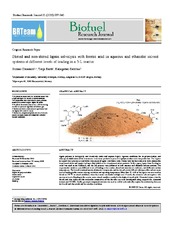| dc.contributor.author | Ghoreishi, Solmaz | |
| dc.contributor.author | Barth, Tanja | |
| dc.contributor.author | Derribsa, Hailegebrel | |
| dc.date.accessioned | 2020-03-25T12:12:34Z | |
| dc.date.available | 2020-03-25T12:12:34Z | |
| dc.date.issued | 2019 | |
| dc.Published | Ghoreishi S, Barth T, Derribsa H. Stirred and non-stirred lignin solvolysis with formic acid in aqueous and ethanolic solvent systems at different levels of loading in a 5-L reactor. Biofuel Research Journal (BRJ). 2019;21:937-946 | eng |
| dc.identifier.issn | 2292-8782 | en_US |
| dc.identifier.uri | https://hdl.handle.net/1956/21585 | |
| dc.description.abstract | Lignin polymer is biologically and chemically stable and requires highly vigorous conditions for de-polymerization, and subsequent stabilization of the monomeric conversion products to prevent re-polymerization and char production. The Lignin-to-Liquid (LtL) process is a solvolytic conversion of lignin with formic acid. Formic acid has been shown to both catalyze the de-polymerization and supply hydrogen that stabilizes the de-polymerization products. In this paper, lignin from Eucalyptus wood was used as the feedstock, and the LtL-process was performed in both aqueous and ethanolic solvent systems. The experimental variables were different levels of loading in the reactor, stirred and non-stirred conditions, and different reaction temperatures. The bio-oil consisted mostly of phenolic compounds, and the bio-oil yields differed with type of the solvent used, level of loading in the reactor, stirring condition, and operating temperature. More than 55 wt.% of the lignin was recovered as bio-oil at 320 °C at stirred conditions when the reactor was loaded at high level. Overall, the ethanolic solvent together with maximum level of loading in the reactor under stirred condition resulted in the highest bio-oil yield. Elemental balance data for bio-oil and char yields and the molecular composition of the bio-oils were also investigated using, respectively, elemental analysis and GC-MS. Finally, principal component analysis was used as well to systematically explore the relationship between the bio-oil and char yields and the reaction conditions. | en_US |
| dc.language.iso | eng | eng |
| dc.publisher | BRTeam | en_US |
| dc.rights | Attribution CC BY | eng |
| dc.rights.uri | http://creativecommons.org/licenses/by/3.0 | eng |
| dc.title | Stirred and non-stirred lignin solvolysis with formic acid in aqueous and ethanolic solvent systems at different levels of loading in a 5-L reactor | en_US |
| dc.type | Peer reviewed | |
| dc.type | Journal article | |
| dc.date.updated | 2020-02-10T07:20:39Z | |
| dc.description.version | publishedVersion | en_US |
| dc.rights.holder | Copyright 2019 BRTeam | en_US |
| dc.identifier.doi | https://doi.org/10.18331/brj2019.6.1.5 | |
| dc.identifier.cristin | 1755223 | |
| dc.source.journal | Biofuel Research Journal (BRJ) | |

